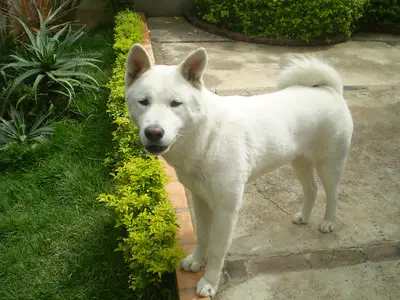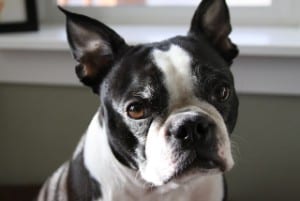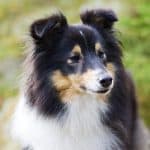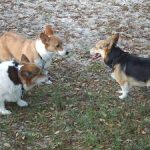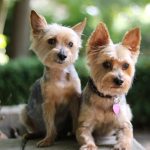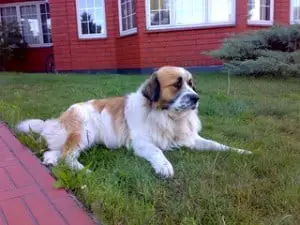
In a previous post, I focused on small Russian dog breeds.
And now I have decided to write another post looking at large Russian dog breeds.
Russia has always fascinated me as a country because their way of life seems to be so different.
And Russia has always projected an image of real strength and military power onto the world stage.
Which is quite appropriate because in my list of eight Russian dog breeds, these dogs are huge.
The smallest breed stands 66 cm (26 inches) high at the withers, whereas the tallest could be up to 81 cm or 32 inches tall.
And that is before I start talking about their weight!
The first breed that I want to highlight, has appeared in quite a few of my lists and I still shake my head as I think about this dog…
Black Russian Terrier
There are many stories in the news today about Russian hackers. There seems to be a trend towards invading public websites as well as private businesses. Well. it may, or may not, come as a surprise that the Russian government has a history of hacking dog genes, as well.
During the late 1940s and early 1950s, Red Star Kennels owned and operated by the Kremlin and located on the outskirts of Moscow embarked on a program to breed the perfect military dog for use in guarding military facilities, detention centers, and border posts.
After combining seventeen different breeds, including the Giant Schnauzer, the Airedale, the Rottweiler, the Caucasian Shepherd, and, perhaps to even out its temperament, the Newfoundland, what they came up with was the Russian Black Terrier. This is a powerfully built canine, standing up to 18” (72cm) and weighing up to the neighborhood of 150 pounds (68kg).
The Russian government had bred the dog for power and ability, with little regard for looks. It wasn’t until private breeders started working with them in the mid-’50’s that this element was taken into consideration, and a more attractive double coat was developed, with longer coarser hair covering a softer inner variety.
They shed regularly and will require grooming a couple of times a week. The name, itself, may be deceiving because, while the dog is, indeed, black, it is not truly a terrier. The RBT is primarily a working dog, used for guarding and protection. It will develop a strong bond with the family with whom it lives and will be particularly protective of young children.
Because of these strong bonds, it may exhibit some aloofness with strangers. The breed is highly intelligent and readily trained. Because they were bred as working dogs, they may need a job to keep them happy. And, like any good soldier, they respond well to training and will follow orders readily.
Borzoi
The Borzoi is another Russian breed of canine, but far different from its Communist-bred cousin. This dog is also known as the Russian Wolfhound, and is the picture of grace and nobility with its tall body, long legs designed for running, and long, silky hair.
The dog was originally bred in Belarus as a hunter, designed to chase down rabbits, foxes, and even, yes, wolves. An adult male can stand up to 32” (81cm) at the shoulder and weigh about 100 pounds (47kg). Its graceful good looks, intelligence, and kind and gentle nature soon lead it to become popular as a companion animal to the royal houses of Europe.
Despite its size, this breed can take well to apartment living, but does not like to be left alone for extended periods. And its lovely coat, which comes in a wide variety of colors like black, white, brindle, cream, fawn, and sable will require a good deal of grooming to retain its beauty.
Caucasian Shepherd
From the Caucasus region of Russia comes yet another fine animal, the Caucasian Shepherd. There are two distinct types of this breed. The Mountain variety has a much heavier body type, and a thicker rougher coat to better protect them from the cold mountain air.
The Steppe variety seems like his little brother, with a lighter coat and less body mass. This breed has been used for centuries to guard homes and livestock against predators, so it should come as no surprise that air is fearless and bold.
But it is also a kind breed, growing particularly attached to its family, and this includes other pets in the household. This breed may exhibit a variety of coat types, from long to short, and the long-haired type must be brushed daily.
They require quite a bit of exercise and would do best with a family who has a large yard and is willing to exercise them daily. The size will depend on the type of dog you choose, but males will grow to be up to 30” (76cm) tall and weigh in at a whopping 170 pounds (77kg).
Central Asian Shepherd Dog
Yet another large working dog coming out of Russia, or what once was the U.S.S.R. is the Central Aian Shepherd. As the name implies, this is a working dog, employed for ages to guard and protect flocks of sheep and herds or goats. This is one of the most ancient breeds, its genealogy dating back 5,000 years.
This canine is big-boned and well-muscled, easily able to live up to any threat. A fully grown male will stand up to 31” (78) tall. And can weigh a hefty 170 pounds (79kg). While not a particularly energetic breed, it will require about an hour of exercise each day.
They can be playful and affectionate with family, and get along well with other pets, even cats. Their coats come in a wide variety of colors, both solids and combinations of colors.
You can find them in black, white, piebald, brindle, rust, and something called dead grass, a shade which can vary from almost white to shades of brown.
East European Shepherd Dog
If you were to see an East European Shepherd dog, you might be forgiven for mistaking it for the more common German Shepherd. This is because this canine was bred during the 1930s in Russia, Belarus, and Ukraine from German Shepherd stock, with the aim of producing a larger and more cold resistant animal. And they succeeded.
This breed is slightly larger, at 30” (75cm) and 110 pounds (50kg), and is highly resistant to cold weather. Because of this, it can easily thrive as an outside pet. It is very loyal and protective of its family, but can be wary of strangers, as is desirable in a good guard dog.
The coat is thick and will require regular brushing, but you should bathe this pet only when absolutely necessary, as shampooing will deplete the oils in its coat which contribute to its resistance of the cold.
Moscow Watchdog
Russia appears to be a hothouse of dog breeding, and one of their very successful results is the Moscow Watchdog.
After the Second World War, with a rising crime rate, the Soviet government felt a need for a breed of watchdog resistant to the harsh climate of the capital.
The Moscow Watchdog is the result of a breeding program involving crossing the Caucasian Shepherd Dog with the St. Bernard of mountain fame. The breed retains positive aspects of its genetic contributors. With the size and strength of the St. Bernard, and the protective and loyal aspects of the Caucasian Shepherd Dog.
This canine is the proverbial gentle giant, standing about 28” tall (71cm} and weighing in at 150 pounds (68kg). Unlike its couch potato forebear, this pet will require some vigorous exercise. Its coat is long, colored white and red, and will require moderate amounts of grooming. Until recently, this dog was seldom seen outside of the former Soviet Union, but is gradually growing in popularity as it makes its way through Europe to the United States.
South Russian Ovcharka
Russia must certainly be home to a lot of sheep, for there are certainly a wide variety of sheepdogs native to the country. One of these is the South Russian Ovcharka, which originated on the steppes of Ukraine between the Black Sea and the Sea of Azov.
The breed has existed for hundreds of years, and its origins are clouded in mystery. Most experts believe that it was bred by combining genes from the Caucasian Shepherd and various smaller European sheepdogs. There also appears to be a bit of wolf in the genetics of the breed, perhaps accounting for its fearlessness.
They were bred for size, as they had to defend their folks from larger predators, such as wolves and bears. Needless to say, they are strong, confident, loyal, and brave, seldom backing down from any threat. They are large, standing 26” (66cm) tall and weighing in the vicinity of 140 pounds (65kg). This breed is lively, active, and can be nervous.
They will require a large fenced area in which to roam. Their hair makes them look like giant fluff balls. Usually white, but sometimes showing a bit of yellow, grey, gold, or dead grass color, the coat is long, thick, and coarse, bushy and slightly wavy.
Hortaya Borzaya
A beautiful breed which comes out of Russia, or, more particularly, Lithuania, is the Hortaya Borzaya, a large and graceful Sighthound with looks that closely resemble a greyhound, but with a wider face more closely resembling a Borzoi. These hounds were bred to pursue and retrieve prey, and return it undamaged to its master.
This means that its bite is soft and its stamina extraordinary. They can stay in the field hunting with their masters for the entire day, resting only briefly between chases. They were bred to hunt in packs, and this means they get along quite well with other dogs in the household. And they will come to consider the family as part of the pack, too, and respond with gentleness and affection. Like the greyhound, these dogs are tall and elegant, about 30” (75cm), and weigh about 77 pounds (35kg) when fully grown.
Their coat is short but dense, allowing them to tolerate colder climates. Their coat is low maintenance, requiring brushing only once or twice a week. This breed varies quite a bit in appearance, and there are five distinct types and multiple subtypes.
Colors are widely distributed, with white, black, cream, sable, red, and brindle all showing up in the breed. The Hortaya Borzaya is a highly energetic breed which requires plenty of wide open spaces to satisfy its need for exercise. Perhaps this is why it is extremely rare, seldom seen outside of rural Russia.

